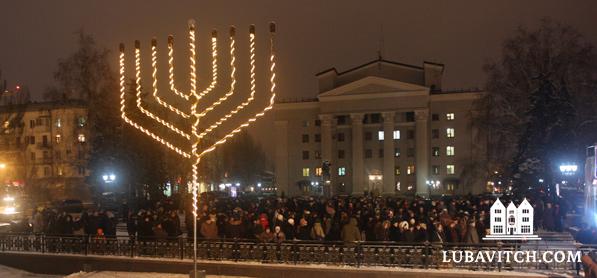(lubavitch.com) “When I was little and lit candles with my family, we used to say that one day a menorah would be lit at the White House. And now look where we are,” said Rahm Emmanuel, Chief of Staff at the White House, as he addressed the crowd that had gathered to light the National Menorah on Monday.
The idea of a national menorah, a project of American Friends of Lubavitch now in its 30th year, was inconceivable before the late 1970s. Back then, most American Jews shied away from public displays of Jewish pride or observance.
Ellen Goldstein, president of Gazelle Marketing LLC grew up in Baltimore in the 1960s, when Chanukah was largely eclipsed by Christmas. “I don’t remember a single public celebration,” says Goldstein, who grew up in a “predominantly secular, Jewish community.”
Goldstein recalls having to “lobby our choir director to add at least one Chanukah song to sing during all of the holiday concerts we gave, and one of these concerts was even performed in a Jewish Nursing Home!”
Today, her own children growing up in Potomac, MD, are experiencing the holiday very differently, and are able to “understand and appreciate more of the joyous Chanukah story.”
Things were even more grim for Jews in the country’s South. Larry Brook, editor and publisher of the Southern Jewish Voice says that while growing up in late 1970s Birmingham, Alabama, he did not see any public celebrations of Chanukah.
“We still had some of the generational ‘fit in’ attitude where we didn’t draw much attention to our differences.” According to Brook, Chanukah generated precious little notice and celebrations “until Chabad arrived here in the mid-80s and lit a huge menorah on an overpass above the Red Mountain Expressway.”
These days, Brook is proud to display his celebration of Chanukah publicly. A 20×20 foot menorah of mini-lights sits on his front lawn in Birmingham.
Indeed, outdoor menorahs have become a familiar sight everywhere, as Chabad representatives around the world put them up not only outside their centers, but in town squares and major city centers. Chabad of New York City’s Upper East Side positions its menorah over the FDR highway, where some one million people will see it over the eight days of Chanukah.
Another marker of Chanukah’s rising currency is the fact that major mainstream media have switched from the Anglicized Hanukkah to the Hebrew spelling and pronunciation of Chanukah. More importantly, Chabad’s interactive educational programming allows Jewish children to engage meaningfully with their Jewish heritage and traditions.
Like thousands of his colleagues from Anchorage to Arad, Rabbi Mendel Silberstein draws large crowds, schools and families, to Chabad’s Dreidel House in Larchmont, New York, where he uses fun, hands-on activities to explore Jewish history and values with the children.
A favorite is the olive press, where children get to crush olives and watch the oil separate from the juice in the centrifuge. As the group observes the oil rising to the top, Silberstein shares a lesson about individual courage, a recurrent theme in the story of Chanukah. He points out that sometimes it is necessary to stand apart for one’s convictions. “Be the best that you can, just like the olive oil that rises to the top,” he says.
And, in many major cities, Chabad organizes an annual parade of menorah-topped vehicles that cruise the thoroughfares with lively Chanukah melodies blaring from the cars, bringing the holiday’s joy to the public.
It’s a far cry from the world that Minka Goldstein grew up in, as a Jewish girl in Danbury, CT, in the 1950s. Goldstein remembers feeling ashamed of her Jewishness, and recalls that “My friends gave me x-mas gifts and I gave up saying we didn’t celebrate. There was no pride in Chanukah at all. It was too difficult to be different.”
That precisely is what the Lubavitcher Rebbe sought to reverse by raising awareness of the holiday throughout the country and around the world. As the only Jewish holiday that specifically calls for public celebrations, the idea of public menorah lightings has proven a perfect strategy.
The first public menorah went up in San Francisco’s Union Square, in 1975. Erected by the late Rolling Stones promoter and Holocaust survivor Bill Graham, it was known as the “mama” menorah because of the thousands of others it inspired globally.
Rabbi Chaim Drizin, Chabad representative to San Francisco at the time, and Zev Putterman, former program director at KQED public radio, approached Graham, and asked for his help in constructing the menorah and staging the event.
At the time it was a dramatic first step. But then, as now, the San Francisco Jewish community was open to new possibilities. Rabbi Drizin rallied representatives of all the city’s Jewish organizations in support of the idea, and met with “practically no objections.” The supersize menorah–25 feet tall by 15 feet wide—went up in Union Square, where it was surrounded by evergreens; the first lighting drew 1,000 people.
As with so many of Chabad’s innovative outreach activities, public menorah lightings quickly caught on and have increased dramatically over the years, drawing ever-larger crowds. Rabbi Mendel Azimov, Chabad representative to Paris recalls that in 1994 there were 7 public Menorah lightings in the city. A combined total of 2,700 attended the lightings. In addition, Chabad of Paris distributed some 1,000 menorahs, 4,000 Chanukah brochures, and 2,000 doughnuts to Jewish residents and tourists across Paris.
Compare those figures to 2008, when 60 public lightings in Paris drew some 16,000 individuals. Distributions also increased exponentially with total figures at 20,000 Menorahs, 45,000 Chanukah brochures and 15,000 doughnuts.
Rabbi Moshe Feller, director of the Upper Midwest-Merkos Chabad House in St. Paul, MN, likes to quote the famous Conservative Rabbi Arthur Hertzberg: “We said, ‘Be a Jew in your home and be a regular citizen in the street.’ The Rebbe said, ‘Be a Jew in the street and you’ll be a Jew in your home.’”

Be the first to write a comment.